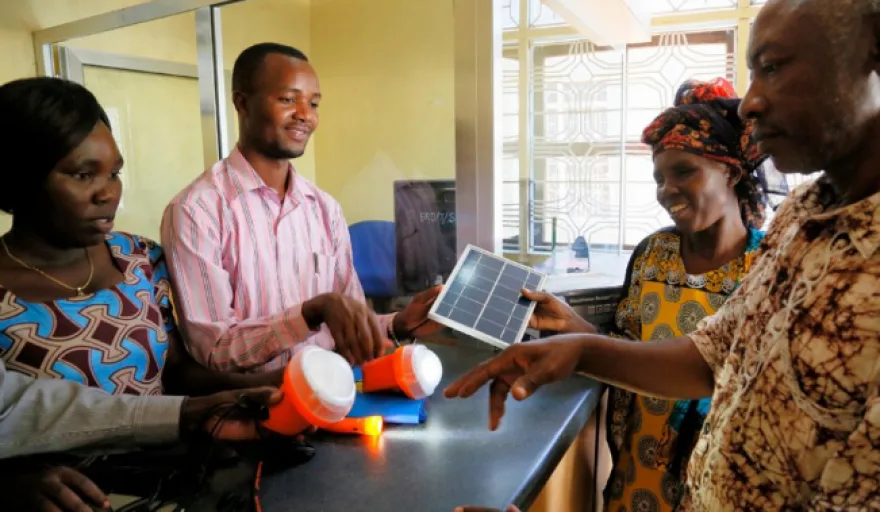Santosh Naidoo of African Infrastructure Investment Managers (AIIM) discusses how off-grid energy innovation can open up access to electricity for millions of unconnected African citizens.
Around 246 million people across the globe live in a household with improved energy access as a direct result of off-grid solar energy since July 2010.
It is also estimated that $9.1 billion has been saved on energy expenditure by using solar lanterns and multi-light systems over the same period. This is part of a phenomenon happening in the poorest communities globally, and represents a new dawn for energy access across the African continent.
The introduction of solar home systems provides significant benefits to local communities across the economic, social and environmental scales. For example, the new off-grid technologies can dramatically transform a household’s lifestyle. A pico solar lantern costing less than $5 can elevate a household from darkness to light, in turn having a multiplier effect for residents’ livelihoods. This means school children are able to do their homework after dark, millions of people no longer have to walk for miles to charge their mobile phones, and women are empowered to become entrepreneurs.
From an environmental perspective, key benefits of using off grid solar products include the reduction of fossil fuel usage. The use of fossil fuels (like charcoal, wood or kerosene) are a health and a fire hazard, as well as a direct contributor to greenhouse gas emissions and consequently, climate change. Additionally, solar products reduce the reliance on fossil fuels for home lighting and cooking needs.
The new technology also reduces the need for residential transmission and distribution networks that are often unaesthetic and expensive to install, with the long-term goal to provide a utility-like infrastructure service. Hence the coining of the term ‘next generation utility’ ushered by an entire new model referred to as Utilities 2.0.
Access to electricity in rural Africa is currently 24.8 percent and the target of Sustainable Development Goal (SDG) 7 – Affordable and Clean Energy – is universal energy access for all by 2030. The significant social and environmental benefits, as well as the price reduction in solar panels and batteries, has catalysed off grid power in Africa and the market has grown into an attractive prospect for various investors.
One of the leading products in the East African market, and AIIM investment, is the BBOXX bPower300 system. It contains a 300 W roof mounted solar panel and a lithium ion battery, which can provide up to 650 Wh of daily usable power, supporting a wide range of appliances including refrigerators, TVs and pedestal fans. The bPower300 units incorporate BBOXX SMART Solar and PULSE technology for remote monitoring and controlling via GSM connectivity. These are proprietary platforms that allow for cutting edge use of data.
BBOXX has created payment plans that are well suited to its customers. The pay-as-you-go (PAYG) system utilises mobile money and allows a customer to make small payments on a per day basis to maintain energy access through their solar home system.
Customers in Kenya and Rwanda usually earn $100-200 per month and spend $8-12 on energy expenditure such as purchasing kerosene, batteries, and charging their phones. BBOXX prices its sales to match these existing energy costs, spreading the cost of a solar system over time to widen its customer base, enabling the masses to have access to clean renewable solar energy.
As an early mover in this space, the PAYG strategy also represents data opportunities going forward. For many customers, this is the first time they are developing a credit history. Expenditure patterns can be tracked. Upselling products can be predicted, and marketing can be targeted. This creates the perfect platform for customers to move up the energy value chain, and receive further utilities on a PAYG basis.
The introduction of off grid solar products at scale has changed the energy landscape. This leapfrogging technology is analogous to mobile phone penetration through Africa in the early 2000s, which left landlines in its wake. With access to energy, comes access to the world. Regional and global news is available on radio and TV. And it won’t be long before people could enjoy browsing the internet on a laptop powered by a solar home system.
We believe that decentralised renewable energy technologies will become a key feature in many parts of Africa. Many governments have growing debt burdens that present obstacles to further investment in grid infrastructure, which can sometimes be unreliable. Energy access is about to change forever, and Africa is leading the way.




























